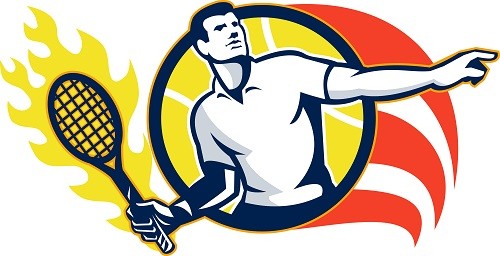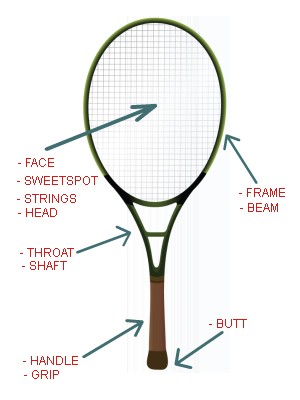|
Tennis Racquets |

There are hundreds of tennis racquet designs on the market. Some, like the Wilson Ultra 100, now even come with smart sensor attachments that will record shot type, swing speed, impact spot, and more. Whether some of this stuff is useless gimmickry or a faster path to improving your game, the verdict is still out.
But one thing is certain; tennis racquet makers continue to introduce innovative materials and technologies that are helping players take their performances to new levels.
In this guide, you will get information and advice for helping you to select a racquet (or stick) that matches your skill level and playing style.
Racquet Construction
Materials
Tennis racquets have come a long way. Until the late 1960’s, they were almost wholly made of wood. But in 1967, the Wilson Sporting Goods company introduced the first metal version.
It was a big hit because it was lighter and stronger than wood. Jimmy Connors was the first major professional tennis player to take it mainstream.
Since that time, tennis frames and racquet technology have continued to evolve and improve. Some of the most popular materials used in the construction of frames include:
– Graphite: This is the most common material used today. It’s lightweight and strong.
– Aluminum: Great if affordability is a top concern for you. While it is still commonly used, many of the best sticks are shifting to composite materials like titanium, graphite, and carbon fiber.
– Titanium: Super strong and ultra light. It helps to create a stiffer frame for added power.
– Kevlar: Lightweight and used to create rigid frames. It’s often combined with graphite to dampen vibration and improve feel.
– Carbon Fiber: A composite material that often includes graphite. It is used to create sticks that are stiffer and easier to control while still allowing for effortless power.
– Wood and Metal Alloys: Still used to make cheaper racquets. But not recommended if you’re serious about playing and improving your game.
Anatomy
 Choosing a tennis racquet can seem like an overwhelming task, but once you understand the principal components and their purpose, it’ll be easy.
Choosing a tennis racquet can seem like an overwhelming task, but once you understand the principal components and their purpose, it’ll be easy.
The first thing we want to do is to provide you with a quick snapshot of the anatomy and lingo of a racquet so that we will be on the same page going forward. Let’s begin.
The 4 primary components include:
1. Head – this is the large oval-shaped area that is used to strike the ball. It houses the strings, and the sweetspot is the center.
2. Shaft/Throat – it is the open triangle area that connects the grip to the head
3. Grip – it is the long handle that you hold, and it also hides part of the shaft
4. Frame – the thickness of it and the materials used for construction will affect power, control, stability, and durability
How Tennis Racquets Are Made
The overall length will also play a significant role in the selection process. But before getting to that stage, let’s discuss how to measure your skill level and the role it plays in choosing a stick.
>>>>Player Skill Guidelines>>>>
| Page 1 | Page 2 | Page 3 | Page 4 | Page 5 |

